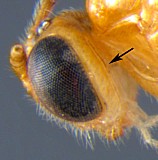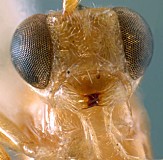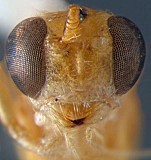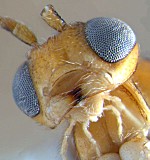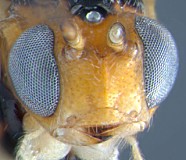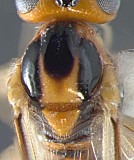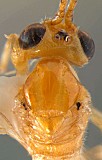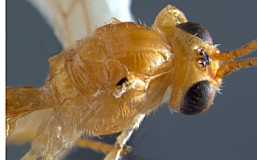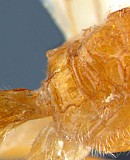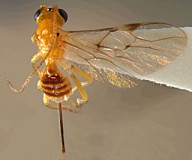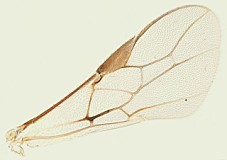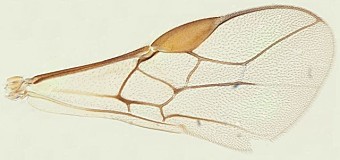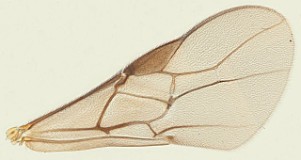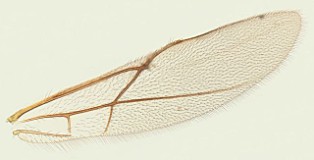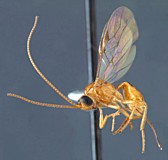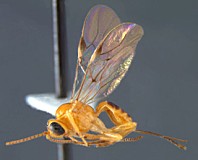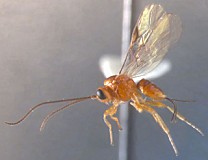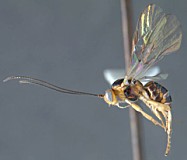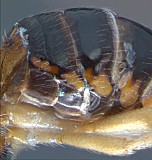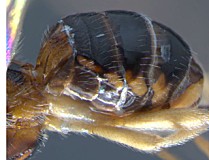Host records are known for about 40% of the described species of
Psyttalia , and these are restricted to the family Tephritidae. About 80% of the records are from fruit-infesting tephritids, with the remainder attacking flower-infesting tephritids. Those attacking tephritids in flower heads are, as a group, morphologically distinct from those attacking tephritids in fruits, and based on field-collected material, there is almost no overlap in host habitat. The evolution of host shifts in these groups of
Psyttalia would be an interesting topic to explore.
Extensive information is available on the biology of Psyttalia concolor (Szépligeti), P. humilis (Silvestri), and P. fletcheri (Silvestri) in association with their use in biological control. More limited information is available on P. incisi (Silvestri) in this regard. Psyttalia concolor was introduced to Italy in an effort to control olive fly shortly after its discovery in Tunisia. Its early use in Italy has been well documented (Silvestri, 1922, [1938]; Delucchi, 1957), as has its subsequent use in augmentation programs following development of mass rearing techniques using medfly as hosts. As a result of these efforts, there is now a considerable amount of information on the developmental biology of Psyttalia concolor, as well as other facets of its biology related to its utility for biological control of fruit pests (Féron, 1954; [Ragusa, 1957]; Biliotti and Delanoue, 1959; Delanoue, 1960, 1961; Arambourg, 1962; Genduso, 1967; [Liotta, 1969]; Raspi and Loni, 1994; Loni, 1997; Canale, 1998; Raspi and Canale, 2000; Canale and Raspi, 2000). P. concolor and P. lounsburyi have been reared from Bactrocera oleae collected from Olea europaea cuspidata in Kenya (Copeland et al. 2004). In experimental studies, P. concolor successfully parasitized second instar larvae of Ceratitis capitata (Wiedemann), and first and second instar larvae of Bactrocera oleae (Rossi) (Canale 1998, Raspi and Canale 2000). P. concolor siculus was introduced in Bolivia in 1968 to control Ceratitis capitata (Bennett and Squire 1972).
Psyttalia humilis, originally collected in South Africa, was successfully established in Hawaii in 1913 against medfly and a detailed biology was published by Pemberton and Willard (1918).
During the exploration phase of the Oriental fruit fly program, several of the opiines from Kenya were variously identified as color varieties of Psyttalia concolor or as Psyttalia perproxima (Clausen et al. 1965). Material from the same localities had been identified as either P. humilis or P. perproxima during an earlier sampling program (Bianchi and Krauss, 1936). Difficulty in identification of these three species is still a problem, and uncertainty over whether or not they are distinct makes it difficult to correctly associate previously published host records. See Rugman-Jones et al. (2009) for a more detailed treatment of this problem.
Much of the biological information on Psyttalia fletcheri and Psyttalia incisi is summarized by Clausen (1978). More recent information can be found in Ramadan et al. (1991). Other species, originating from Kenya, are currently being cultured in France, Guatemala, California, and Hawaii; see species pages for Psyttalia humilis , Psyttalia concolor , Psyttalia lounsburyi , and Psyttalia ponerophaga .
There are numerous host records for members of the expanded
concolor species group as defined here. A few species, notably
P. efoveolata,
P. inquirenda,
P. somereni, and
P. walkeri, have been reared only from fruits, with the host fly unknown (
Silvestri 1913;
Fischer 1972a,
b,
c). Three of the species,
P. dacicida,
P. lounsburyi, and
P. ponerophaga, are parasitoids of olive fly,
B. oleae (
Silvestri 1912,
1913,
1916b;
Copeland et al. 2004;
Sime et al. 2007;
Daane et al. 2008), and have thus far been recorded only from this host.
Psyttalia concolor is also a parasitoid of
B. oleae and was originally described from specimens reared from olives. It is capable of attacking a wide variety of other fruit-infesting tephritids both in its native range and in areas where it has been introduced. In addition to
Bactrocera, known hosts include tephritid species in the genera
Anastrepha Schiner,
Ceratitis MacLeay,
Capparimyia Bezzi,
Carpomya Costa, and
Dacus Fabricius (
Wharton and Gilstrap 1983).
Psyttalia makii has been recorded from both
Bactrocera and
Carpomya (
Wharton and Gilstrap 1983) while
P. dexter,
P. perproxima, and
P. phaeostigma have all been reared from various species of
Dacus (
SIlvestri 1913;
Steck et al. 1986;
Kimani-Njogu et al. 2001).
Psyttalia perproxima is primarily a parasitoid of various
Ceratitis and
Trirhithrum Bezzi species while
P. phaeostigma, which is mainly known as a parasitoid of
Dacus ciliatus Loew and other cucurbit pests, has additionally been recorded from
Ceratitis and
Carpophthoromyia.
Psyttalia cosyrae,
P. distinguenda,
P. humilis, and
P. insignipennis have all been reared from species of
Ceratitis (
Silvestri 1913;
Wilkinson 1927;
Wharton et al. 1999;
Mohamed et al. 2003, though
insignipennis may have a broader host range (
Wharton et al. 1999) and
humilis may have been reared on other hosts at least briefly during attempts to redistribute it from Hawaii for biological control of other tephritid pests (
Clausen 1978;
Wharton 1989). For a recent species-level treatment with additional host records, see
Rugman-Jones et al. (2009). The temperate species
P. ophthalmica and
P. rhagoleticola are both parasitoids of
Rhagoletis (
FIscher 1972b;
Tobias 1977) and
P. brevitemporalis was described from specimens reared from a species of
Myoleja (
Tobias (1998)). Finally,
Silvestri (1913) recorded
P. inconsueta from
Carpophthoromyia tritea Walker. Though
Fischer (1987) placed
inconsueta in his group B, based on the wing venation as illustrated by
Silvestri (1913), the species is otherwise more similar in sculpture and facial features to other members of the
concolor species group, and at least one of the wings on the type series has fore wing m-cu interstitial rather than postfurcal.
Although the hosts recorded above for the concolor species group are fruit-infesting tephritids, the only known host of P. dexter develops in fruits that are pod-like (Silvestri 1913). Similarly, I have seen specimens that are not easily distinguished from P. concolor, reared from Coelotrypes Bezzi infesting flowers of Convolvulaceae. Thus, a few caveats need to be attached to the generalizations about the types of hosts attacked by members of the concolor species group. Also, because of the evidence for host associated differentiation in this group, as exemplified by P. halidayi, published host records need to be carefully verified.

